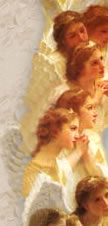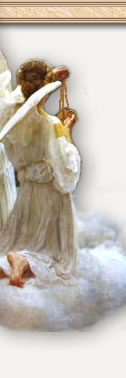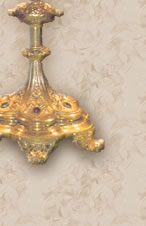




 |
|

|
|
|||||||||||
|
|
|
|
||||||||||||
 |
|
|
||||||||||||
 |
|
 |
|
|||||||||||
|
|
||||||||||||||
 |
 |
|
|
|
|
The Wave of the Future: The cover article in the June 7-14 issue of the Jesuit journal America contained the good news that Archbishop Rembert Weakland is upset. Anything that upsets this Archbishop is good news for every Catholic with a true sensus Catholicus, a sense of what being a Catholic really means. Archbishop Weakland is upset because the liturgical renewal upon which, as a "bishop in the trenches," he had set such hope, has been "totally derailed." He admits that "after the Council abuses arose throughout the Church," but insists that these "all too frequent 'abuses' were, however, the product of zeal and exuberance, not of bad will." He also insists, tautologically: "I can honestly and truthfully say that the aberrations that arose in the late sixties from excessive zeal and exuberance had begun to run their course and to disappear by the early eighties." "The essentials of good liturgy," he continues, "were being emphasized and the needed sense of the sacred was being established. I had hoped that such a trend could be continued so that by the end of the 1980s we would be able to experience the effects of a true renewal." The renewal that the Archbishop had expected was, he lamented, "totally derailed" and his hopes were "shattered." He has no problem in locating the reason for the derailment. Before revealing it I must stress that i this article is not a hoax, and that reference to the relevant issue of America will confirm that he really did say what I am about to quote him as saying: "My hopes, however, were shattered. What totally derailed the liturgical renewal, from the point of view of this bishop in the trenches, was the decision of Pope John Paul II made I am sure, with great anguish to grant in 1984 the indult that allowed the Tridentine usage to flourish again." Well, now we know! The failure of the so-called liturgical renewal is due not to the inherent defects of the official reform itself, and the abuses which have accompanied it from the very first days, but because the Tridentine usage was allowed to flourish again. It is interesting to note that those who prefer the Tridentine Mass are not described by the Archbishop as being motivated by "zeal and exuberance." They are evidently men "of bad will." He continues: "Just at the moment when the situation was beginning to settle down and the deeper and more spiritual aspects of the renewal were becoming possible, a whole new battle began, one in which the renewal itself was called into question or where everyone seemed free to project his or her personal views on how the renewal of the Council shuld have taken place. As well-meaning as that decision to broaden the Tridentine usage was, one cannot emphasize enough how devastating the results have been." It hardly needs saying that the Archbishop's statements consist of no more than gratuitous assertions. Not a shred of evidence is adduced to support them. I am sure that not a single reader of this journal will recollect experiencing the least indication of a true liturgical renewal getting under way in the eighties, or any time since Vatican II. Let us examine Archbishop Weakland's allegations. The first point to take note of is his repeated use of the word "renewal." As any dictionary will make clear, to renew means to bring back to an original condition of freshness and vigor, to recreate, rejuvenate, regenerate. All the empirical evidence proves that the post-Vatican II liturgical renewal exists, and has only existed, in the minds of bishops and liturgists living in Ivory towers, and not in the trenches, where priests and laity who love the Church and love the Mass have suffered so long and been smothered by the unrelenting barrage of litugical aberrations poured down upon them from these towers. The reality of what has taken place since the Council has been expressed perfectly by Msgr. Klaus Gamber in his book The Reform of the Roman Liturgy. It is the one book on the post-Vatican II liturgical reform which every Catholic who loves the Church should own. It is the book on the post- Vatican II liturgical reform which Archbishop Weakland would least wish you to own, which is the best recommendation I can think of for buying it. Monsignor Gamber is undoubtedly one of the greatest liturgists of this century, perhaps the greatest, and his book was endorsed by three cardinals including Cardinal Ratzinger, who described him as "the one scholar who, among the army of pseudo- liturgists, truly represents the liturgical thinking of the center of the Church."[1] Monsignor Gamber insists correctly that what we have experienced is not a renewal but a debacle that worsens with each passing year. He writes: "The liturgical reform, welcomed with so much idealism and hope by so many priests and lay people alike, has turned out to be a liturgical destruction of startling proportions a debacle worsening with each passing year. Instead of the hoped-for renewal of the Church and of Catholic life, we are now witnessing a dismantling of the traditional values, and piety on which our faith rests. Instead of the fruitful renewal of the liturgy, what we see a destruction of the of the Mass which had developed organically during the course of many centuries."[2] All the available empirical evidence endorses the judgment of Msgr. Gamber, and refutes that of Archbishop Weakland. The Council fathers stated clearly in the Liturgy Constitution that the implementation of its proposed reforms was intended to "impart an ever-increasing vigor to the Christian life of the faithful; to adapt more suitably to the needs of our own times those institutions which are subject to change; to foster whatever can promote union among those who believe in Christ; to strengthen whatever can help to call the whole of humanity it to the household of the Church." From the very first changes the opposite was true. We have witnessed, as Msgr, Gamber expressed it, "a debacle worsening with each passing year." Throughout the whole of what is now referred to as the "First World," Mass attendance has collapsed. Far from calling the whole of humanity into the household of the Church, the Catholic faithful have abandoned her on a scale unprecedented since the Reformation. I do not wish to argue that this hemorrhage was due entirely to the liturgical changes, but what is beyond any dispute is that the aims of the Liturgy Constitution were not achieved. There has been no renewal. The Archbishop, in fact, admits this himself. He accepts that there was no renewal until the eighties (as a result of "well-intentioned" abuses), and that the renewal that would have taken place in the eighties was derailed by the authorization of the Tridentine Mass. Ergo, no renewal. From France to New Zealand, from England to the United States the picture is identical. It is one of plunging Mass attendance, empty seminaries, empty convents and an exodus from the priesthood. What must be described as the collapse of American Catholicism was fully documented in the statistical analysis provided in the Summer 1996 issue of The Latin Mass. These statistics also prove that the collapse began soon after the closure of the Council, prior to which almost every aspect of Catholic life subject to empirical verification showed an annual increase. It is nonsensical to claim that the 1984 indult played any part at all in hampering what would otherwise have been a fruitful renewal, and the Archbishop must know this. This indult led to the creation of no more than twelve weekly Tridentine Masses; it strains credulity to claim that a traditional Mass in 0.06 percent of American parishes could have had any effect whatever in halting a national trend towards positive renewal. Archbishop Weakiand is particularly critical of the 1988 Motu Proprio Ecclesia Dei and its papal admonition that a wider and more liberal use of the indult of 1984 be granted by local bishops. The American bishops were very slow in reacting to the clearly expressed wishes of the Holy Father, and it was not until the early nineties that an appreciable number of bishops authorized weekly Masses. Those who do so are still in a minority even today. The impact of the authorization of the Tridentine usage on parish life in the U.S. in the eighties cannot even be described as negligible it was virtually nonexistent. The liturgical debacle worsened with each year in the eighties, just as it had done in the seventies and sixties, and as it is doing in the nineties, because it was flawed from the very beginning. It is very significant that in his article the Archbishop refers only to the U.S. In my capacity as President of the International Una Voce Federation I have, in the past three years, visited Scotland, Ireland, France, Italy, Germany, Belgium, Holland, the United States, Canada, Australia and New Zealand. In every instance the overall picture conforms to the assessment of the post-Vatican II "renewal" given by Fr. Louis Bouyer in 1970: "Unless we are blind, we must even state bluntly that what we see looks less like the hoped-for regeneration of Catholicism than its accelerated decomposition."[3] In not one of these countries is there the least indication that this decomposition is coming to an end, or that a burgeoning liturgical renewal was derailed by the reestablishment of the Tridentine usage. In some, such as Germany, Holland, Belgium and Scotland, episcopally approved Tridentine Masses hardly exist at all. In Scotland Mass attendance has been described by one bishop as "in a free-fall situation" an incontrovertible fact which cannot be linked to the Tridentine Mass. It is also incontrovertible that the vast majority of the faithful throughout the West no longer assist at Mass at all. Those who were not assisting at Mass before the Council have not been brought back, and in country after country many, sometimes most, of those who were assisting before the Council no longer do so. In countries such as France and Holland the percentage of Catholics at Mass each Sunday has declined to a single digit. In the U.S., attendance has declined from 71 percent in 1963 to 25 percent in 1993, a decrease of 65 percent. If we consider this decline in terms of souls rather than bare statistics, it means that in the U.S. twenty-four million fewer Catholics attend Mass now than was the case before the Council. During that period there has been a dissensions which, to use the huge increase in the Catholic population, and so the picture is far worse than these bare statistics suggest. The March 1994 issue of the excellent Australian Catholic journal AD2000 examines the manner in which a detailed survey of Mass attendance in the Diocese of Townsville reflects the overall picture of a collapse of Catholic practice on that continent. The official survey examined in the article was entitled "Where Have All the People Gone?" It reveals a figure of only 12 percent in 1993, which will decline to about 6 percent at the turn of the century. Commenting on the survey, the AD2000 columnist remarked: "Nowhere in the document is there any hint that the "reforming" policies pursued over the past twenty years in liturgy, religious education, seminary and religious life, biblical studies and moral teaching might be contributors to the disaster represented by the Mass attendance statistics.... Just how much further attendance must decline in Townsville and elsewhere before botched reforms are halted and admissions of failure forthcoming is not yet clear, but we should not hold our breath." The reality as opposed to the myth of what has taken place since the council was assessed accurately by Cardinal Ratzinger in a statement published in the December 24, 1984 English edition of L'Osservatore Romano: "Certainly the results [of Vatican II] seem cruelly opposed to the expectations of everyone, beginning with those of Pope John XXIII and then of Pope Paul VI: expected was a new Catholic unity and instead we have been exposed to self-destruction. Expected was a new enthusiasm, and many wound up discouraged and bored. "Expected was a great step forward; instead we find ourselves faced with a progressive process of decadence which has developed for the most part under the sign of a calling back to the Council, and has therefore contributed to discrediting it for many. The net result therefore seems negative. I am repeating here what I said ten years after the conclusion of the work: it is incontrovertible that this period has definitely been unfavorable for the Catholic Church." (my emphasis) The fact that this period has been unfavorable to the Catholic Church is due to no small extent to the prohibition of the Tridentine Mass. Even had the 1970 Missal been an improvement upon that of 1570, the prohibition of the latter was certain to be harmful for the Church. The folly of changing liturgical rites to which the faithful were accustomed was appreciated by many eminent authorities long before Vatican II. Cardinal Newman, while still an Anglican, observed with his customary perception that nothing but harm could come from interfering with established forms of worship: "Granting that the forms are not immediately from God, still long use has made them divine to us; for the spirit of religion has so penetrated and quickened them, that to destroy them is, in respect of the multitude of men, to unsettle and dislodge the religious principle itself. In most minds usage has so identified them with the notion of religion, that the one cannot be extirpated without the other. Their faith will not bear transplanting." [4] Cardinal Gasquet rightly remarked that: "A Catholic, who sees in the living liturgy of the Roman Church the essential forms which remain still what they were 1,200, perhaps nearly 1,400, years ago, cannot but feel a personal love for those sacred rites which come to him with all the authority of centuries. Any rude handling of such forms must cause deep pain to those who know and use them. For they come to them from God, through Christ and through the Church. But they would not have such attraction ire they not also sanctified by the piety of so many generations who have prayed in the same words and found in them steadiness in joy and consolation in sorrow."[5] Professor Johannes Wagner, Director of the Liturgical Institute of Trier, reached the same conclusion when he stated: "History has proved a thousand times that there is nothing more dangerous for a religion, nothing more likely to result in discontent, incertitude, division and apostasy, than interference with the liturgy and consequently with religious sensibility."[6] Cardinal Ratzinger has echoed these authorities in his new autobiographical book From My Life, Remembrances 1927-1997, which will be published in English in the fall of 1997. The Cardinal expressed his belief that the suppression of the old Mass marked a "break in the history of the liturgy the consequences of which could only be tragic." He accepted that "the ecclesial crisis in which we find ourselves today depends in great part on the collapse of the liturgy." "I was dismayed at the ban on the old Missal," he went on, "since such a development had never been seen in the history of liturgy. The impression was given that this was completely normal." It was the publicity given to Cardinal Ratzinger's new book which provoked Archbishop Weakland's diatribe. He complains bitterly that: "Seen from this vantage point in the trenches, the decision that caused confusion and harm in the Church was not that made by Pope Paul VI to permit only one Latin rite, but the decision to permit the Tridentine usage to enjoy equal footing with the reformed rite. When this fact is coupled with all the semiofficial statements from Roman officials, uttered without contradiction from higher authority, that call into question the entire liturgical reform of Vatican II, confusion in the trenches is inevitable." The claims made in this paragraph range from the ridiculous to the outrageous. Firstly, Archbishop Weakland is evidently claiming that confusion and harm in the Church began only in 1984 when the Tridentine Mass was authorized once more. He admits in his article that the renewal had not gotten under way until the eighties, due to abuses produced by zeal and exuberance. Secondly, this paragraph contains a far-from-subtle attack upon Pope John Paul II. Archbishop Weakland states unequivocally that the Holy Father has caused harm and confusion in the Church by authorizing the Tridentine Mass. Thirdly, the semiofficial statements to which he refers must evidently be those made by Cardinal Ratzinger. His Eminence has only one superior, and so when Archbishop Weakland denounces "higher authority" for failing to contradict the Cardinal, he is attacking the Pope once more. Throughout his article Archbishop Weakland presumes that the reform which has been imposed upon us was mandated by the Second Vatican Council the "liturgical reform of Vatican II." Even a cursory examination of the liturgy Constitution makes it clear that Msgr. Gamber is correct in claiming that: "One statement we can make with certainty is that the new Ordo of the Mass that has now emerged would not have been endorsed by the majority of the Council fathers."[7] This statement is endorsed by Fr. Joseph Gelineau, a priest whose liturgical credentials Archbishop Weakland would certainly consider impeccable, a priest who was described by Archbishop Bugnini as one of the "great masters of the international liturgical world."[8] In his book Demain la liturgie, Fr. Gelineau states: "It would be false to identify this liturgical renewal with the reform of rites decided on by Vatican II. This reform goes back much further and goes forward far beyond the conciliar prescriptions (elle va bien au-dela). The liturgy is a permanent workshop (la liturgie est un chantier permanent).[9] So there we have it. In place of the moderate reform sanctioned by the Liturgy Constitution, the Mass of the Roman Rite, surely the Church's greatest treasure apart from the Scriptures themselves, has been reduced on a practical level to a permanent workshop, something done by the people rather than an action of Christ. In his book Feast of Faith, Cardinal Ratzinger accepts Fr. Gelineau's assessment: "Today we might ask: Is there a Latin rite any more? Certainly there is no awareness of it. To most people the liturgy appears to be rather something for the individual congregation to arrange."[10] The Cardinal wrote these words in 1986, and his question as to whether there is still a Latin Rite can now be answered in the affirmative. Yes, there is still a Latin rite recognizable as such, the rite found in the Missal of 1962 which, to the chagrin of Archbishop Weakland, is flourishing once more. In city after city in the U.S. it is attracting large and predominantly young congregations. Furthermore, there are now at least fifteen flourishing priestly societies and monastic communities, Benedictines in particular, which use the 1962 Missal exclusively, and which are swamped with vocations. They are attracting young men, and in the convents of traditional religious sisters young women, who were not even born when the Missal of Pope Paul VI was promulgated in 1970. Monsignor Gamber assessed the reality as opposed to the myth of the renewal perfectly when he wrote: "In the end, we will all have to recognize that the new liturgical forms, well intentioned as they may have been at the beginning, did not provide the people with bread, but with stones."[11] The only possible solution to the litugical debacle has been "In the final analysis, this means that in the future the traditional rite of Mass must be retained in the roman Catholic Church...as the primary liturgical form for the celebration of Mass. It must become once more the norm of our faith and the symbol of Catholic unity throughout the world, a rock of stability in a period of upheaval and never-ending change.[12] Is this an impossible dream? No one who was present in the Chartres on Pentecost Monday this year, as I was, would have thought so. The world's most beautiful cathedral was packed to the doors with young Catholics for a Solemn High Tridentine Mass, which they sang with one voice una voce and with tremendous enthusiasm, after marching almost seventy miles in three days, and camping out at night. There were at least 15,000 pilgrims present, with an average age of 20-25. Thousands of them could not find a place inside the cathedral and sang the Mass outside. Until about ten years ago these fervent young Catholics were denied access to the cathedral; the doors were actually locked to exclude them. This year the Tridentine Mass was sung by Cardinal Angelo Felici, President of the Ecclesia Dei Commission, in the presence of the papal nuncio to France a very significant mark of Vatican approval, as was the message of encouragement from the Holy Father himself. At least 150 young priests who are pledged to celebrate the Tridentine Mass exclusively took part in the procession and distributed Holy Communion. A few days later in London I was present at a meeting of a rapidly expanding society of young diocesan priests who celebrate the Tridentine Mass at every possible opporutnity, and whose ambition is to celebrate it exclusively. As the subscription list of The Latin Mass makes clear, there are seminarians with the same ambition throughout the United States. The days of such aging liberals as Archbishop Weakland are numbered. The Tridentine Mass is indeed the Mass that will not die, the "most beautiful thing this side of Heaven," as Fr. Faber expressed it. It can be truly described as the once and future Mass, and the young priests and seminarians dedicated to its celebration, and the young people who flock to their Masses, are indeed the wave of the future. Archbishop Weakland laments that his hopes are shattered. Good. If he wishes to whine let him whine, for whining is the privilege of old men who have been overtaken by events. * * * * * Footnotes 1. K. Gamber, The Reform of the Roman Liturgy (Roman Catholic Books, P.O. Box 255, Harrison, New York, 10528, 1993), p. xiii. Referre to as RRL in subsequent notes. 2. RRL, p. 9 3. L. Bouyer, The Decomposition of Catholicism (Chicago, 1970), p. 1. 4. J.H. Newman, Sermon "Ceremonies of the Chuch," included in Newman Against the Liberals: 25 Classic Sermons by John Henry Newman, selected from Parochial and Plain Sermons, with a Preface by Michael Davies, (Roman Catholic Books, P.O. Box 2286, Ft. Collins, CO 80522), p. 147. 5. F. Gasquet & H. Bishop, Edward VI and the Book of Common Prayer (London, 1890), p. 183. 6. Reformation aus Rom (Munich, 1967), p. 42. 7. RRL, p. 61. 8. A. Bugnini, The Reform of the Liturgy: 1948-1975 (Collegeville, Minnesota, 1990), p. 221. 9. J. Gelineau, Demain la liturgie (Paris, 1976), p. 10. 10. J. Ratzinger, Feast of Faith (San Francisco, 1986), p. 84. 11. RRL, p. 109. 12. RRL, p. 109.
|
|



♦ About The Mass ♦ Resources ♦ How To Help ♦ Contact Us ♦